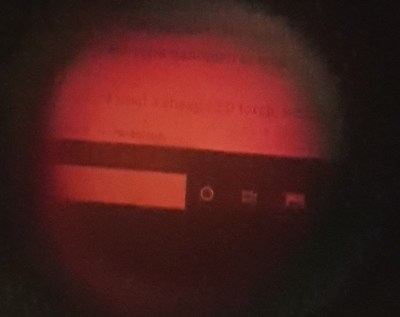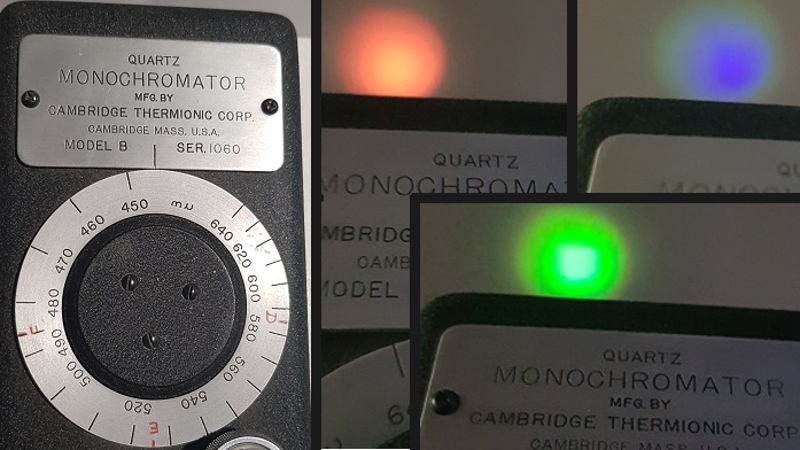A monochromator is an optical instrument that permits only a narrow selection of wavelengths to be transmitted from a source, and the particular model [Doug] obtained renders visual light monochromatic by way of a mechanically-adjusted system of mirrors and diffraction gratings that allows only the selected wavelength to pass. The big dial is how the operator selects the desired wavelength, and is labeled in ‘mu’ (or milli-micro), but [Doug] helpfully points out the more modern term for that is nanometers.

How does it work? Light enters the device via an opening at the base, and only the selected wavelength exits from the top. The dial’s range is from 450 nm to 640 nm (representing violet-blue to red), which [Doug] demonstrates by shining a white LED flashlight into the unit and showing how only green, red, or blue will exit from the top depending on the setting of the dial.
An interesting side note is that with this particular device, images can be rendered monochromatic but otherwise remain intact. [Doug] demonstrates this by viewing a small section of his LCD monitor through the device, as shown in the photo he managed to capture.
It’s an interesting piece of vintage equipment that shows what is possible with passive optical components and a clever mechanical design. These devices are therefore entirely manually-operated tools (at least until someone sticks a stepper motor to the adjustment dial to create an automated scanner, that is.)
















It’s worth looking back at the late Commander Hatfield’s Solar Observatory that used tuning forks to filter specific optical wavelengths, hydrogen alpha I think. I never understood it, but always wanted to build one.
Cmdtr Hatfields Obituary – I can’t find the article that appeared in Wireless World, but I think it used a similar principle to filter the light; https://britastro.org/journal_old/pdf/121-1hatfield.pdf
How does that thing work? I want (to build) one. Is a more modern and affordable alternative available?
Mirrors and diffraction grating, first sentence…
Not really. This is a special kind of monochromator, called a Lyot monochromator. This means that it can produce an image instead of scrambling all the position information into a spot of light. Instead of a prism or a grating, this uses a combination of quartz crystals of two chiral types, placed alternatively in an array, separated by polarizers.
I think the easiest way to build this yourself would be to shine a broad spectrum light source into a prism and then use a thin slit to window a small section of the spectrum.
Generally an input slit, focusing mirror, grating or prism, a collimating mirror and an exit slit. The input and output slits are needed to narrow down the selected wavelengths which I dont thing the one in the post is using, it could be, The narrower the slit the higher the resolution but the less light gets through. So slits are selected for their bandwidth with a particular grating.
You can rig something up using a CD and other parts, there are people that make spectrometers with a web cam, but if you specifically want a monochromater you will probably be better off just buying a cheap used one off ebay.
https://www.berthold.com/en/bioanalytic/knowledge/glossary/monochromator/
Diffraction grating is one way, prism and slit is another, but this particular unit apparently works by passing light through quartz — this other comment links to a PDF that explains how a unit that sure looks like the one in the post works: https://hackaday.com/2021/07/27/vintage-monochromator-makes-monochromatic-light-mechanically/#comment-6367654
Shop eBay for “Monochromator” until you find a Jarell-Ash for less than $250. https://www.idealvac.com/Thermo-Jarrell-Ash-(Model-82-410)-0.25-Meter-Monochromator-Spectrograph-Infrared-IR/pp/P101023
This one looks fine. https://www.ebay.com/itm/133447995283 You don’t want that drive box anyway because you will use a stepper to control wavelength. It has a pair of slits and some epoxy or something around the input or output port. Under the lid I can see all the parts are there and in the right places. Swap the gears on the outside and get less than 0.1nm per step (10 angstroms). The grating even looks reasonably clean. Don’t clean or touch it! There is a special polymer that can be applied and peeled but is expensive. Old school method uses collodion, let dry and peel.
Nice, friend and I picked up a very similar unit made by Bausch and Lomb, it has several drop in modules that go in the same housing for different wavelength ranges. One is for a NIR range of light but you still see a visible spectrum though it since you also see the second order set of wavelengths though it which is something that spectrometers have filters installed to stop from passing.
Send it to Big Clive for a teardown.
Please don’t.
There is already to much broken vintage optical stuff, that can be put to do useful things, if some neanderthal won’t take it apart.
I’d hardly call Big Clive a “neanderthal”.
Big Clive is the pure opposite of ““neanderthal” despite being Big.
I was referring to all the f***kers that left broken pieces of optic marvels on ebay.
This is maybe a naiive question, but could something like this be used to determine to mineral composition of a surface? I’ve been scanning some rocks at work and working with plain RGB optical images. It’s been quite challenging to extract any useful information (very low contrast results) – but I think a spectral scan would in theory “non-destructively” tell you much much more as each mineral should have distinct absorption spectra. I just figured this wasn’t so readily accessible.
I assume you can’ t just jazz up a tricorder with a diffraction grating :) Yet thinking of the physics behind it, I don’t actually see why it’s not possible. I’m probably missing something
The tech you’re looking for is Raman spectroscopy.
You can do some of this under a microscope with “stereology” and spectra of individual crystals and bits. There are scanning schemes to illuminate a tiny spot. The data will get big fast since you save a spectra that is probably around a couple thousand values for each point in the scan. Multi-spectra imaging gets out of hand quickly. I have 96GBytes of RAM in a 12 core Mac Pro just in case :-)
Thanks for the tip!
Okay… so you can sorta make a tricorder… :)) I guess in principle finding someone with a Raman microscope could be a solution. It looks fairly complicated/expensive and on a smaller scale than I’d normally be interested in. I’m imagining more like a stationary camera or modified scanner bed and not a tiny microscope stage or SEM scales. But it might be worth a try. It definitely looks much faster than doing thin sections..
Thought I could DYI something simpler with a camera at least as a first pass to see if I get anything interesting. I’m afraid since most of the features are due to trace impurities in calcite crystals it might not come out as pretty as some pics I see online. I don’t wanna go down a rabbit hole over nothing
Do the minerals you’re looking for have any fluorescence under UV light?
If so, you could shine on UV light at night and take long exposure photograph to see if you detect any fluorescence.
There is a lower cost and faster way to get a good multi-spectra image. There are dichroic filters that are linear variable filters. If the imaging light can pass through a small enough hole, a series of images as the filter is moved can be done very quickly. I have seen them made on a disk that rotates like a filter wheel. But all a quick search shows is linear in a straight line and quite expensive. It takes two of them to get an image that is not color shifted spatially? https://www.deltaopticalthinfilm.com/applications/lvf-monochromators/
It seems to be the model of the picture: no grating or prism but rotatory power of quartz
http://www.minsocam.org/ammin/AM37/AM37_158.pdf
Whoa, thanks for that link — fascinating! And it sure does look like the same model!
There is only a small difference: your picture is the B model, on the publication it ‘s the A model. The dial for wavelengths choosing rotate in the opposite direction (clock wise or counter clock wise)
OK, so what happens if you shine a laser into it? (I’m assuming a black hole of some sort.)
It will pass the laser only when the wavelength dial will match the wavelength of the laser.
In the 80s I worked in a precision grinding shop where we used a monochromatic polarized light source and an “optical flat”, which was a quartz disk, to gauge the flatness of a surface. By placing the quartz disk in direct contact with the ground surface and illuminating it with the monochromatic light, we could see bands on the surface. (If you’ve ever seen polarized light pass through an acrylic part while wearing polarized sunglasses, you’ve seen this effect too.) If the bands were consistent and parallel to each other, we knew it was flat. If they expanded or contracted, or curved more than a specified amount, the surface was not flat and therefore unacceptable.
To achieve these high precision flat parts, we rough ground the parts by magnetically holding them to the bed of an ordinary high precision flat bed grinder. This grinder was super nice, and regularly delivered an Ra of around 6-8 microinches on most finished parts. Not mirror quality, but very nice for steel, and hardly what anyone would call rough. Of course these flat parts had to have a much finer finish, around Ra 3, so we had to finish them differently. We finished them by holding the parts at the appropriate angle in a sacrificial jig in a lapping machine. (Pretty much every part of a lapping machine that comes in regular contact with the lapping compound is ultimately sacrificed.) As I recall, that was a tedious job.
Apparently, all that work we put into those parts was worth it, because I think they also could have been finished on a wire EDM machine in a single operation that would have also given an exceptionally smooth surface finish.
As mentioned above, contrary to the opening sentence, this device does not use a grating or mirrors at all.
It depends on the wavelength-dependent birefringence of quartz, in conjunction with a set of rotatable polarizers, to select which wavelength(s) of polarized light to pass. It’s called a “Lyot Filter”
Unfortunately, the birefringence of quartz is fixed, so it requires that fairly complex mechanical mechanism to select the wavelength.
There’s a very nifty new material that has an electrically-tunable birefringence that can be used to do this much more easily, with no mechanical elements to rotate. You may have heard of it. You’re probably using a type of it right now. It’s called “Liquid Crystal”.
For more info, search for Liquid Crystal Tunable Filter